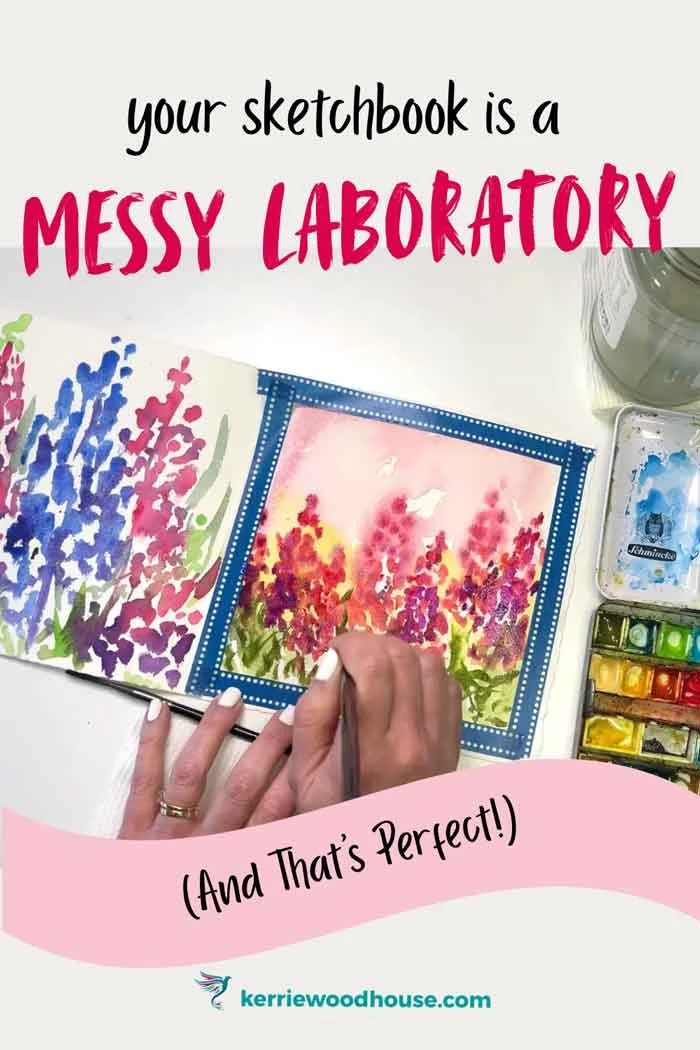Watercolour Confidence: Simple Tips to Fill Your Sketchbook Without Fear
Disclosure: This post may contain affiliate links. That means if you buy something we may possibly get a small commission at no extra cost to you.
Have you ever abandoned a creative project because it didn't seem to be turning out exactly as you might have hoped?
I recently discovered a very old project of mine that looked like it could have been a lot of fun, but I'm guessing my fears, doubts, and a little bit of perfectionism got in the way and made me give up on it.
Bit sad, don't you think? So let's talk about why this happens and how we can reclaim the joy in our creative hobbies.
Let’s not let our sketchbooks feel like a test we are afraid to fail!
The Watercolour Project I Almost Lost to Fear
I must have started this watercolour flower journal project so long ago because I have almost no recollection of creating it. It seems to be the makings of a little handmade journal for watercolor flowers. I must have picked a size for the journal, chosen the paper, cut the pages, even filled a few pages, and done the cover.
But I guess I must have not loved the way some of these pages turned out because that's where I seem to have left it.
When I discovered these unfinished pages while I was tidying up my office, I thought, "What a fun little project, and I'm quite excited to start painting them." Flowers are still one of my favourite subjects to paint in watercolour - there are so many flowers to paint and there are so many different ways to approach painting them in watercolour.
Want to see it?
I am making a whole series of videos about the revival of this little project!
What Self-Sabotage Looks Like Before You Pick Up a Brush
The thing that interests me more is the decision I seem to have made not to bind the pages and create the sketchbook before I started painting. I think this is what self-sabotage looks like before you even pick up a brush.
I'm guessing I would have done that because I was worried that some of my pages wouldn't quite be good enough for the finished sketchbook. So doing it this way round would allow me to leave them out of the binding if that turned out to be the case.
Oh, now I feel a bit sorry for my former self because there is an irony there. Trying to prevent failure, I almost guaranteed it. I was effectively setting myself up to fail.
Common Ways We Sabotage Our Watercolour Practice
I think this is really only one form of creative self-sabotage. Tell me if any of these sound familiar:
Choosing lovely expensive supplies and then stalling because you're a bit afraid to use them
Getting stuck in the endless planning phase of the project and never quite getting round to starting
Waiting for the right time to begin - and somehow that right time never seems to arrive
Comparing your beginner work to expert artists on social media
Starting too many projects without finishing any, then feeling overwhelmed
Hoarding "good" paper for special occasions that never come
Overthinking every brushstroke instead of letting the paint flow naturally
I think all of these are just symptomatic of the pressure we feel. Or perhaps we put on ourselves to make everything worthy or good enough.
Breaking Free from These Patterns
The truth is, these patterns all stem from the same root: fear of not being good enough. But here's what I've learned - watercolour is forgiving in ways we often don't expect. Paper can be painted over, "mistakes" can become happy accidents, and imperfect pages can teach us more than perfect ones ever could.
Instead of trying to avoid failure, what if we embraced the learning that comes with it? What if we treated our sketchbooks as practice spaces rather than final exam papers?
When Did We Decide Learning Had to Look Perfect?
I think it comes from a bit too much adulting. I find that eventually there comes a time when we feel like we're supposed to be at least adequately good at all the things that we do. You know, being grown-ups and all.
And as sensible grown-ups, we start to believe that everything we do needs to at least be useful. I think we forget about the importance of play at any age, and we possibly deprive ourselves of the right to be a beginner.
That really is a joy.
Remember: Your Sketchbook is a Messy Laboratory
Joy is exactly what projects like this are supposed to be about, in my opinion, and especially what sketchbooks are for. Let's not forget that sketchbooks are supposed to be messy laboratories. Otherwise, we wouldn't call them sketchbooks. We'd call them masterpiece books, surely?
Don't let the social media highlight reel effect give you the wrong idea. I mean, of course, a sketchbook can end up being filled with page after page of magnificent artworks. But it can also be a red-hot mess of scribbles and scrawled notes and telephone doodles.
A sketchbook may or may not include coffee stains, half a shopping list, and that password you were never supposed to write down for security reasons. And if you want to create a sketchbook filled with barely recognisable stick figures, you go right ahead.
We have every right to do that sort of thing, at any age.
Choose the Freedom of a Messy Sketchbook
Of course, those Instagram-worthy sketchbooks are amazing to behold, but there is a different quiet power in having a safe and private space in which to do whatever you please with little to no regard for how it ends up looking.
Let's exercise our creative resistance and choose the freedom of a messy sketchbook. Grant our little projects the liberty of turning out just as they are, not as we think they ought to be.
That's the mindset I'm aiming for as I finish this little project. Not that I think every project you start needs to be finished.
There is nothing wrong with abandoning creative projects. I truly believe that creative waste is simply a part of the process. In fact, I wrote a bit more about that in this post.
I chose to complete the little unfinished project that I came across because it felt like fun - the best reason to paint! But I could also have chosen to cut up the painted pages for collage, use any clean pages for testing swatches or making tiny paintings, or indeed, throw it all in the recycling bin. These are all valid options, and I dont think we should have any guilt about the choices we make in this regard.
But if you are looking for some practical tips and suggestions to help you get on with filling up that watercolour sketchbook, I can help… read on!
Practical Sketchbook Tips to Build Your Watercolour Confidence
Here are some simple ways to make your watercolour sketchbook feel less intimidating and more inviting:
Start Small and Simple
Fill corners first - try small flower studies or colour swatches in unused spaces
Use both sides of the paper - it's meant to be used, not preserved
Date your pages - you'll love seeing your progress over time
Paint the same subject repeatedly - flowers, leaves, or cups of tea make great practice subjects
Make it Functional
Include written notes alongside your paintings - what worked, what didn't, color mixes you loved
Test colour combinations on the same page as your painting
Use it for planning - sketch out ideas for larger works
Document inspiration - paste in photos, color references, or quotes that inspire you
Give Yourself Permission
Paint over pages you don't love - sometimes the best paintings happen on top of "failed" ones
Leave pages unfinished - there's no rule that says every page must be complete
Mix media freely - watercolour, pen, pencil, collage - it's your space
Fill it with experiments - new techniques, colour mixing, brush techniques
The goal isn't perfection; it's practice, play, and progress.
Your Permission Slip to Create Imperfectly
Remember: sketchbooks are supposed to be messy laboratories where you have every right to experiment, play, and yes - even fail. The joy isn't in creating perfect pages; it's in the freedom to explore, learn, and rediscover the beginner's mind at any age.
So grab that watercolour set you've been saving, open to a fresh page, and give yourself permission to make something beautifully imperfect.
Your sketchbook is waiting.
Are you on your own painting journey?
One of these might be useful…









